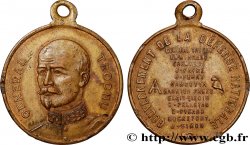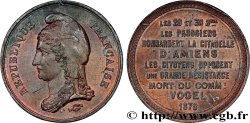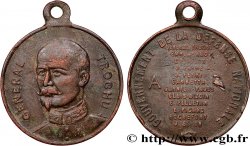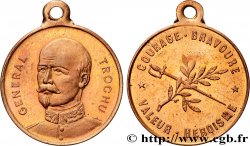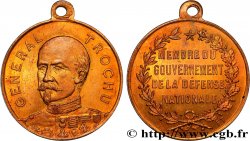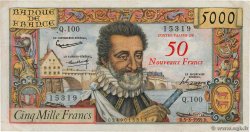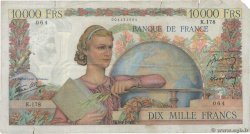fme_412578 - GUERRE DE 1870-1871 Médaille de souvenir du siège de Paris
Nicht verfügbar.
Artikel auf unserem Online-Shop verkauft (2022)
Preis : 120.00 €
Artikel auf unserem Online-Shop verkauft (2022)
Preis : 120.00 €
Type : Médaille de souvenir du siège de Paris
Datum: 1871
Name der Münzstätte / Stadt : 75 - Paris
Metall : Zinn
Durchmesser : 37,5 mm
Stempelstellung : 12 h.
Graveur BARBERON
Gewicht : 24 g.
Rand lisse
Kommentare zum Erhaltungszustand:
Superbe médaille avec de beaux reliefs, un bel aspect et son brillant de frappe
Vorderseite
Titulatur der Vorderseite SOUVENIR DU SIÈGE DE PARIS // 1870-1871.
Beschreibung Vorderseite La ville de Paris personnifier debout sur les barricades entourées de soldats.
Rückseite
Titulatur der Rückseite RÉPUBLIQUE FRANCAISE // JETON / DE / PRÉSENCE.
Beschreibung Rückseite Légende en 4 lignes.
Kommentare
Le siège de Paris est un épisode de la guerre franco-allemande de 1870. Investie à partie du 17 septembre 1870, la ville est rapidement encerclée par les troupes allemandes, que la résistance parisienne n'empêche pas de progresser au Nord de la Loire durant l'automne 1870.
À aucun moment la défaite des armées françaises n'avait été imaginée. C'est donc dans la précipitation que la ville de Paris est mise en défense.
Au moment où le siège de Paris semble inéluctable, le gouvernement engage un immense effort de travaux de défense qui a fait, en quelques semaines, d'une ville jugée hors d'état de se défendre, une place véritablement imprenable. Le génie militaire, l'artillerie, et le ministère des travaux publics, auxiliaire du génie et de l'artillerie, y ont concouru.
L'enceinte continue est divisée en 9 secteurs, avec un certain nombre de fortifications qui ne sont pas terminées, comme sur les hauteurs de Montretout et de Châtillon puis abandonnées par les troupes en place. Ces abandons allaient coûter cher aux Français. En effet, c'est du plateau de Châtillon que les prussiens installeront leur grosse artillerie qui foudroiera les forts et la capitale.
Afin de contrarier, autant que possible, la marche des Prussiens sur Paris, huit régiments de cavalerie, commandés par les généraux Gustave Coste de Champéron et Jean-Henry Reyau sont dirigés sur Meaux avec ordre de harceler l'ennemi..
The Siege of Paris was an episode of the Franco-German War of 1870.. Invested from September 17, 1870, the city was quickly surrounded by German troops, which Parisian resistance did not prevent from advancing north of the Loire during the autumn of 1870..
At no time had the defeat of the French armies been imagined. It was therefore in haste that the city of Paris was put on defense.
At a time when the siege of Paris seemed inevitable, the government began a huge effort of defensive works which, in a few weeks, transformed a city deemed incapable of defending itself into a truly impregnable place.. Military engineering, artillery, and the Ministry of Public Works, auxiliary to engineering and artillery, contributed to this..
The continuous enclosure is divided into 9 sectors, with a certain number of fortifications which were not completed, such as on the heights of Montretout and Châtillon then abandoned by the troops in place. These abandonments were going to cost the French dearly.. In fact, it was from the Châtillon plateau that the Prussians installed their heavy artillery which struck down the forts and the capital..
In order to thwart, as much as possible, the Prussian march on Paris, eight cavalry regiments, commanded by Generals Gustave Coste de Champéron and Jean-Henry Reyau, were sent to Meaux with orders to harass the enemy..
À aucun moment la défaite des armées françaises n'avait été imaginée. C'est donc dans la précipitation que la ville de Paris est mise en défense.
Au moment où le siège de Paris semble inéluctable, le gouvernement engage un immense effort de travaux de défense qui a fait, en quelques semaines, d'une ville jugée hors d'état de se défendre, une place véritablement imprenable. Le génie militaire, l'artillerie, et le ministère des travaux publics, auxiliaire du génie et de l'artillerie, y ont concouru.
L'enceinte continue est divisée en 9 secteurs, avec un certain nombre de fortifications qui ne sont pas terminées, comme sur les hauteurs de Montretout et de Châtillon puis abandonnées par les troupes en place. Ces abandons allaient coûter cher aux Français. En effet, c'est du plateau de Châtillon que les prussiens installeront leur grosse artillerie qui foudroiera les forts et la capitale.
Afin de contrarier, autant que possible, la marche des Prussiens sur Paris, huit régiments de cavalerie, commandés par les généraux Gustave Coste de Champéron et Jean-Henry Reyau sont dirigés sur Meaux avec ordre de harceler l'ennemi..
The Siege of Paris was an episode of the Franco-German War of 1870.. Invested from September 17, 1870, the city was quickly surrounded by German troops, which Parisian resistance did not prevent from advancing north of the Loire during the autumn of 1870..
At no time had the defeat of the French armies been imagined. It was therefore in haste that the city of Paris was put on defense.
At a time when the siege of Paris seemed inevitable, the government began a huge effort of defensive works which, in a few weeks, transformed a city deemed incapable of defending itself into a truly impregnable place.. Military engineering, artillery, and the Ministry of Public Works, auxiliary to engineering and artillery, contributed to this..
The continuous enclosure is divided into 9 sectors, with a certain number of fortifications which were not completed, such as on the heights of Montretout and Châtillon then abandoned by the troops in place. These abandonments were going to cost the French dearly.. In fact, it was from the Châtillon plateau that the Prussians installed their heavy artillery which struck down the forts and the capital..
In order to thwart, as much as possible, the Prussian march on Paris, eight cavalry regiments, commanded by Generals Gustave Coste de Champéron and Jean-Henry Reyau, were sent to Meaux with orders to harass the enemy..








 Berichten über einen Fehler
Berichten über einen Fehler Die Seite drucken
Die Seite drucken Teilen meiner Auswahl
Teilen meiner Auswahl Stellen Sie eine Frage
Stellen Sie eine Frage Einlieferung/Verkauf
Einlieferung/Verkauf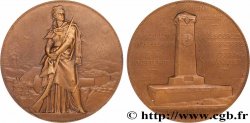
 Details
Details